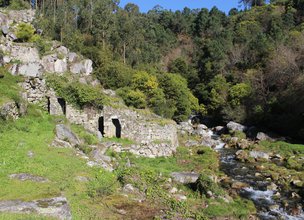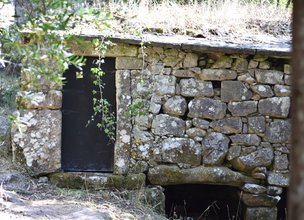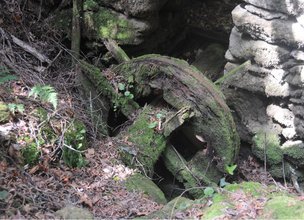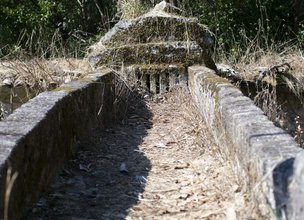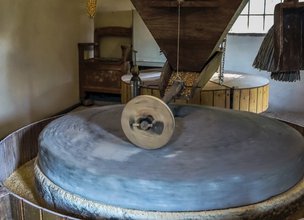The functional value of geodiversity: the example of water mills
Poço Negro Cascades are located in Pêgo stream. Due to its high slope, more than 60 watermills were built along this stream. The ruins of the watermills can be visited in this Local Natural Monument.
For a long time, the use of mills played a key role in the life of rural communities. Mills may use two types of power - wind or water - that may be used in different ways. This circumstance is reflected in the upbuilding of the mills, in the regime ownership, and in their use.
In Alto Minho, watermills are the most common but in some places near the coast between Viana do Castelo and Esposende windmills can also be found. Nevertheless, the high amount of rain and the rough landscape favoured the existence of watermills (Figs. 1 and 2).
Sometimes, small semi-industrial facilities with commercial purposes appeared offering a number of services besides cereal gridding, such as wood sawing, flax maceration, river crossing. This circumstance favoured the trade with the opposite bank and turned the place into a crossing point for the local communities thus countering their isolation.
Watermills may have different types of architecture which fall into two major types: with a vertical wheel outside the building or presenting a horizontal wheel inside the building. The first are more common in plain areas and the second in mountains.
Usually, watermills with a vertical wheel are large masonry buildings with a gable roof. They are located on the banks of the final course of bigger rivers where the ground is flatter. The water of the river is dammed by a loose stone weir that directs it to a floodgate which in turn diverts the water so that it hits the blades of the wheel (Fig. 3).
The levada is a channel that diverts the water from its bed leading it to the mill. After moving the caster, the water may return to its natural course, it can be diverted to other mills or it can follow downstream (Fig. 4).
Grinding takes place when cereal grain is crushed between two hard surfaces, the grindstones, which crush the cereal and turn it into flour. The mill replaces muscle strength by water or wind power thus allowing the existence of a continuous rotating movement (Fig. 5).
In Poço Negro Cascades, it is possible to see watermills with an horizontal wheel in small buildings covered by simple rooftops (Esq. A). Here, the small dimension of the watermills is related to local conditions: a rough landscape with small streams where it is difficult to find a piece of land that enables the construction of big buildings.
The access roads to Poço Negro waterfall mills were handled by their owners. Cleaning, maintenance and construction of sidewalks facilitated the access. The mill worked day and night and sometimes shift changes took place in the middle of the night when access could be unsafe. Grooves dug by the wheels of the wagons that carried the cereal and flour can be seen in the pavement near Poço Negro watermills.
Poço Negro Cascades are located in Pêgo stream. Due to its high slope, more than 60 watermills were built along this stream. The ruins of the watermills can be visited in this Local Natural Monument.
For a long time, the use of mills played a key role in the life of rural communities. Mills may use two types of power - wind or water - that may be used in different ways. This circumstance is reflected in the upbuilding of the mills, in the regime ownership, and in their use.
In Alto Minho, watermills are the most common but in some places near the coast between Viana do Castelo and Esposende windmills can also be found. Nevertheless, the high amount of rain and the rough landscape favoured the existence of watermills (Figs. 1 and 2).
Sometimes, small semi-industrial facilities with commercial purposes appeared offering a number of services besides cereal gridding, such as wood sawing, flax maceration, river crossing. This circumstance favoured the trade with the opposite bank and turned the place into a crossing point for the local communities thus countering their isolation.
Watermills may have different types of architecture which fall into two major types: with a vertical wheel outside the building or presenting a horizontal wheel inside the building. The first are more common in plain areas and the second in mountains.
Usually, watermills with a vertical wheel are large masonry buildings with a gable roof. They are located on the banks of the final course of bigger rivers where the ground is flatter. The water of the river is dammed by a loose stone weir that directs it to a floodgate which in turn diverts the water so that it hits the blades of the wheel (Fig. 3).
The levada is a channel that diverts the water from its bed leading it to the mill. After moving the caster, the water may return to its natural course, it can be diverted to other mills or it can follow downstream (Fig. 4).
Grinding takes place when cereal grain is crushed between two hard surfaces, the grindstones, which crush the cereal and turn it into flour. The mill replaces muscle strength by water or wind power thus allowing the existence of a continuous rotating movement (Fig. 5).
In Poço Negro Cascades, it is possible to see watermills with an horizontal wheel in small buildings covered by simple rooftops (Esq. A). Here, the small dimension of the watermills is related to local conditions: a rough landscape with small streams where it is difficult to find a piece of land that enables the construction of big buildings.
The access roads to Poço Negro waterfall mills were handled by their owners. Cleaning, maintenance and construction of sidewalks facilitated the access. The mill worked day and night and sometimes shift changes took place in the middle of the night when access could be unsafe. Grooves dug by the wheels of the wagons that carried the cereal and flour can be seen in the pavement near Poço Negro watermills.
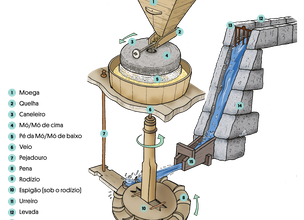
Esq. A - Different parts of a watermill in Poço Negro Cascades.
Location
Areosa
Coordinates
Lat: 41.7225593
Long: -8.8488853
Hello little one!
I'm Piquinhos and I can help you learn more about the Geopark!
Technical details
Esq. A - Different parts of a watermill in Poço Negro Cascades.
Child Mode
Discover the geopark in a simpler format, aimed at the little ones.
Clique ENTER para pesquisar ou ESC para sair
